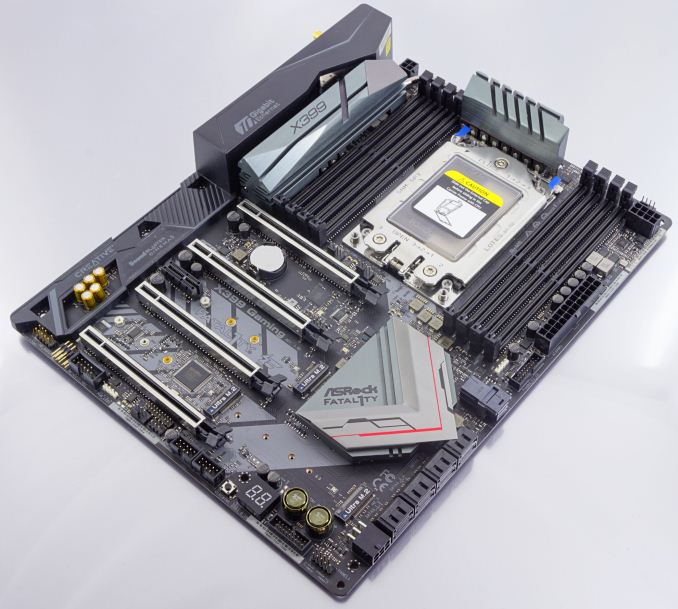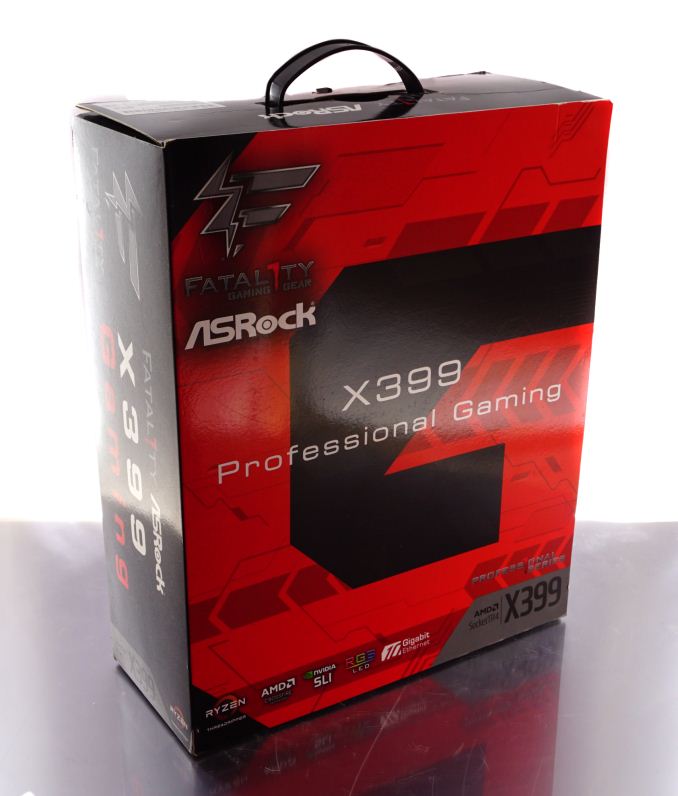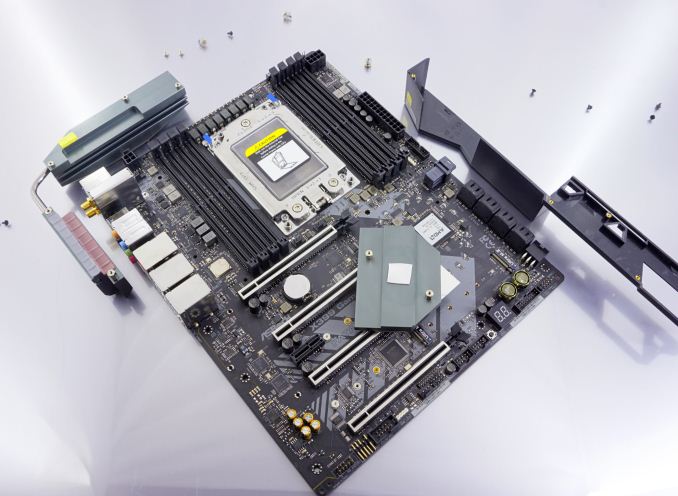The ASRock X399 Professional Gaming Motherboard Review: 10G For All
by E. Fylladitakis on July 5, 2018 8:00 AM EST- Posted in
- Motherboards
- AMD
- Gigabyte
- ASRock
- Asus
- 10GBase-T
- ThreadRipper
- X399

There are only very few motherboards currently available for Ryzen Threadripper processors. ASRock is the company with most AMD X399 motherboards and they only have three available. Still, ASRock took a more daring approach with their designs and also released the one and only mATX motherboard for Ryzen Threadripper. In this review we will be having a look at their currently best AMD X399 motherboard, the Fatal1ty X399 Professional Gaming.
The ASRock X399 Professional Gaming, as the name suggests, is a motherboard that is being marketed towards advanced gamers. Although the Ryzen Threadripper (currently) is not an appealing processor for casual gaming, when a gamer also wants to be concurrently downloading, chatting, and transcoding a video in the background while streaming a game online, the many cores of the Threadripper start making sense. The X399 Professional Gaming is ASRock's most featured-packed motherboard, with a very impressive list of specifications. However, with a price tag of $440, the X399 Professional Gaming also is one of the most expensive Ryzen Threadripper motherboards available. We will be seeing if that cost is justified in this review.
AnandTech's AMD Ryzen Threadripper and X399 Motherboard Coverage
- The AMD Ryzen Threadripper 1950X and 1920X Review: CPUs on Steroids
- An AMD Threadripper X399 Motherboard Overview
- Analyzing Threadripper Thermals: Big Base Cooling Wins
- The GIGABYTE X399 DESIGNARE EX Motherboard Review
- AMD Reveals Threadripper 2 : Up to 32 Cores, 250W, X399 Refresh
- GIGABYTE’s X399 Aorus Extreme: The Threadripper 2 Halo Motherboard
- MSI's New Threadripper 2 Motherboard on Steroids: X399 Creation
- New EKWB Threadripper X399 Monoblocks for GIGABYTE and MSI
ASRock Fatal1ty X399 Professional Gaming Overview
The ASRock X399 Professional Gaming is a motherboard that has been designed to entice advanced gamers. Even the nickname of the former well-known former esports player, Johnathan "Fatal1ty" Wendel, appears along with the motherboard's name to help with the marketing of the motherboard. However, after having a closer look at the motherboard and its specifications, it feels as if the X399 Professional Gaming is having an identity crisis, which isn't necessary a bad thing.
The design of the X399 Professional Gaming is not in any way extravagant, as one would expect from a top-tier motherboard that is almost exclusively targeting gamers. On the contrary, the aesthetic design is subtle, yet elegant, focused on simple geometric shapes. Onboard RGB lighting is present but is limited around the chipset's heatsink, with headers for additional LED strips. We also spotted very high-quality components, such as the Nichicon solid-state capacitors that account for every single capacitor on this motherboard.
In terms of connectivity, the ASRock X399 Professional Gaming supports up to three M.2 PCIe ×4 drives, one U.2 PCIe ×4 drive, and eight SATA drives. Each of the M.2 sockets have four PCIe lanes with no sharing between them and/or with other devices, except for one of the M.2 slots to be switched with the U.2 port. Using the U.2 connector will disable one of the M.2 ports entirely. It is not possible for two devices to be installed with shared lanes.
A look at the rear panel of the motherboard reveals that the ASRock X399 Professional Gaming has three network interface controllers (NICs), plus the Wi-Fi 802.11ac/Bluetooth 4.2 module. Two of the NICs are typical gigabit chips from Intel (211AT) but the third is an Aquantia 10GBASE-T chip, the AQC107. This level of network connectivity is needless for a gaming motherboard and none of the used chipsets are designed exclusively for gaming, it should be noted. The use of three NICs is one of this motherboard's unique features but, on the other hand, this approach does not make much sense for a gaming motherboard. A gaming-specific NIC such as a Killer E2500 would make the motherboard more appealing to gamers, whereas the more expensive Aquantia 10G chip primarily serves other users.
The second feature that stands out is the 11-phase (8+3) power design with a fully digital PWM controller and separated CPU connectors. We will examine the circuitry in more detail in the following pages of this review. The sound chipset is provided by Realtek and is the ALC1220. It supports the Sound Blaster Cinema 3 software and ASRock is using Nichicon's golden audio-specific capacitors to drive the physically isolated audio channels. The motherboard also has a USB 3.1 Gen 2 controller that provides one Type-A and one Type-C port.
We are unsure why ASRock decided to focus their marketing efforts on just gamers with this motherboard. Overall, it feels as if the designer was initially trying to create a reliable and fully-featured motherboard that would be an appealing product for practically every advanced user, not just gamers.












43 Comments
View All Comments
nagi603 - Thursday, July 5, 2018 - link
Frankly, I'm thrilled with the board. It may bear "gaming" in the name, but that's a misnomer: it's a powerful workstation board with wide-ranging gaming options. And I'm quite thankful for the built-in 10Gbit ethernet when there is only a single PCIe slot for extra cards (besides the 4 16x GPU intended ones).nagi603 - Thursday, July 5, 2018 - link
Also, the fan options on HW montior tab are already like that on my current Z79 board, so I'm not sure if AsRock changed it after that and returned with the X399, or the reviewer is unfamiliar with AsRock motherboards in general.Jorgp2 - Thursday, July 5, 2018 - link
Umm.A PCI-E x1 slot only gives you 8gbps.
Most PCI-E NICs are at least 8x.
nagi603 - Friday, July 6, 2018 - link
Yeah, I have a few 2-port intel 540's that are 8x, but Asus has a cheap Aquantia-based NIC (XG-C100C) that runs on a 4x port.nagi603 - Friday, July 6, 2018 - link
(Also, yes, I did not think the comment through... yes, you definitely need more than a 1x for a 10G, so you'd have to waste a 16x port for 10G if the board didn't have it integrated)AdrianB1 - Saturday, July 7, 2018 - link
I can live with a 10 Gbps NIC using a 1x PCIe port, jumping from 1 Gbps to ~7.5 Gbps effective transfer rate is a huge improvement for a home user. Also PCIe 4 is coming, it will be more than enough for a 10 Gbps NIC.monglerbongler - Tuesday, July 10, 2018 - link
Can you live with either >>$1,000 for a small port count managed switch, or else ~$300-$600 for a literal 4 or 6 port unmanaged switch?No soho routers with 10g right now. Maybe when broadcom releases some silicon with it built in will we see the usual suspect start to release practical soho routers.
My house is wired. I'm sure most enthusiasts wire their homes. But I would simultaneously argue that most home wiring jobs, even for advanced gamers and semi-professional usage still leverage retail soho routers, either for the NAT/router functionality (eg to get internet access piped to all of the devices), and/or for the wifi. You might use a 2nd router as an access point or some multiport switch to expand the wired functionality.
But are you ready to spend the anywhere from the same to 3x the price of this high priced motherboard to even use the 10G?
If the goal is future proofing, my response is:
wait until the future is here and then just buy a new system with 10g at a lower price/better incorporation.
eek2121 - Thursday, July 5, 2018 - link
While I would like 10 GB Ethernet, the MSI X399 Carbon features a 10+3 VRM design, which can easily push 4.1 GHz or 4.2 GHz depending on the chip. 4.2 GHz passed Prime95 at 1.45V on my chip and 4.1 GHz passed at 1.325. I have even been able to run benchmarks at 4.3 or 4.4 GHz, though Prime95 fails. Also 4.3 and 4.4 GHz required some obscene voltage, which unfortunately degraded my chip slightly.I can't wait to RMA my board ( broken/crushed pins, but they only charge $45 to replace.) Currently I am on an ASUS X399-E and haven't been able to get it past 4.0 GHz. Likely due to the 8+3 VRMs and 8+4 EPS connectors (the MSI was 10+3 and 8+8).
Arbie - Thursday, July 5, 2018 - link
Why, except for a transient bit of fun, would anyone overclock Ryzen? It already clocks itself exceptionally well. If you override those features you're just throwing power away, with no perceptible gain in daily use.halcyon - Friday, July 6, 2018 - link
You said it: fun (and curiosity/learning).